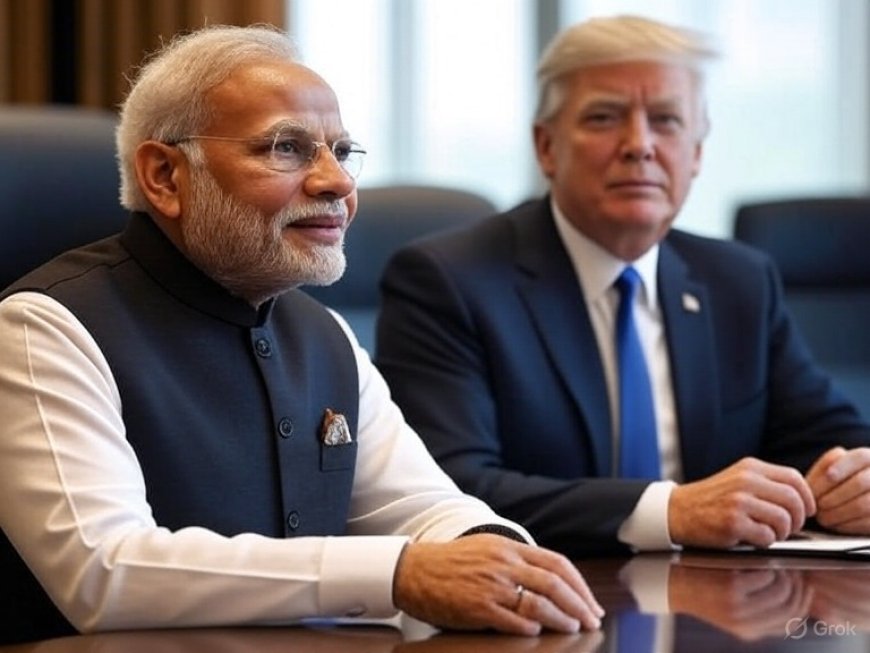India-US Trade Talks Hit Roadblock as Agriculture and Tariff Disputes Stall Progress Before July 9 Deadline
India-U.S. trade talks stall over agriculture and tariff disagreements ahead of the July 9 deadline. Explore key issues and implications for both economies.

High-stakes trade negotiations between India and the United States have hit a critical impasse just days before the July 9 deadline, with both sides unable to reconcile key differences over domestic agricultural protections and reciprocal tariffs. The setback casts uncertainty over a much-anticipated bilateral trade agreement that was expected to inject new momentum into one of the world’s most consequential economic relationships.
Despite multiple rounds of high-level discussions held over the past two months in Washington and New Delhi, trade officials have reportedly failed to bridge gaps on core issues, including India’s support to domestic farmers and U.S. demands for greater market access in dairy, poultry, and e-commerce sectors.
Key Sticking Points: Domestic Agriculture and Market Access
At the center of the deadlock is India’s steadfast insistence on protecting its domestic agricultural sector, which employs over 40% of its population. New Delhi has refused to dilute subsidies, import restrictions, and minimum support prices (MSPs) that it considers vital for food security and rural livelihoods.
U.S. negotiators, meanwhile, have pushed for the removal of what they view as trade-distorting policies. In particular, they have raised objections to:
-
India's tariff regime on dairy and poultry products;
-
Restrictions on genetically modified (GM) agricultural imports;
-
Local content requirements that allegedly violate WTO rules.
According to a senior official from India’s Ministry of Commerce,
“While we remain committed to a fair and mutually beneficial agreement, we will not compromise the livelihood of Indian farmers to accommodate foreign agricultural giants. Food sovereignty is non-negotiable.”
Tariff Concerns and Digital Trade Barriers
Another flashpoint in the negotiations has been tariff structures and emerging digital trade norms. U.S. trade representatives have long called for reduced tariffs on information technology products and medical devices. They have also criticized India’s data localization mandates and increasing regulation over digital commerce.
From the Indian side, the response has been firm but cautious. Officials argue that:
-
Tariff flexibility is necessary to protect nascent industries;
-
Data localization is a matter of national security and consumer protection;
-
Foreign e-commerce platforms must adhere to domestic regulatory frameworks.
This friction has also been compounded by India's concerns over the continued imposition of high U.S. tariffs on steel and aluminum imports, which were initiated during the Trump administration and only partially reversed.
Political Calculations on Both Sides
With the U.S. gearing up for its 2025 presidential primaries and India navigating key state elections, political sensitivity has added another layer of complexity to the talks. Neither government wants to appear weak on domestic economic priorities, particularly in areas as politically charged as agriculture and trade sovereignty.
Washington is under pressure from American dairy lobbies and technology giants to secure expanded access to Indian markets. Conversely, New Delhi is wary of alienating its rural base or being seen as yielding to Western corporate interests.
Trade analysts point out that the lack of progress may not necessarily mean collapse, but rather a pause for political recalibration.
What’s at Stake for Both Nations
An agreement between India and the U.S.—two of the largest democracies and fastest-growing economies—could open doors to:
-
Enhanced bilateral trade surpassing USD 200 billion annually;
-
More secure supply chain cooperation in semiconductors, pharmaceuticals, and rare earths;
-
Joint innovation in green tech, digital infrastructure, and space collaboration;
-
Deeper alignment in international forums like the Quad, WTO, and Indo-Pacific Economic Framework (IPEF).
Failure to finalize the deal, however, could stall this momentum and embolden competitors, especially in the Asia-Pacific region.
Industry Reactions and Diplomatic Optimism
Despite the deadlock, both governments have reiterated their commitment to continuing dialogue. India’s Commerce Minister Piyush Goyal, in a brief statement to the media, said:
“Talks have not broken down. They are continuing. There are genuine differences, but also genuine efforts to find common ground.”
The U.S. Trade Representative's office echoed similar sentiments, noting that "constructive engagements are ongoing and a deal remains achievable."
Meanwhile, Indian industry bodies such as FICCI and CII have urged both sides to “rise above narrow interests” and work toward a comprehensive and forward-looking trade pact.
Conclusion
As the July 9 deadline looms, the India-U.S. trade negotiations hang in the balance, emblematic of the broader challenge facing global trade diplomacy today: balancing national priorities with global integration. While the latest roadblock reflects deeply rooted differences, it also offers both sides a moment of reflection to design a more equitable, resilient, and inclusive trade relationship for the future.
Whether this current pause becomes a prolonged stalemate or a stepping stone toward meaningful compromise will define the trajectory of India-U.S. economic ties in the years to come.














